Arabian coffee
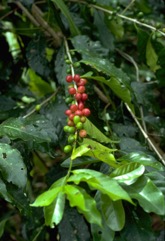
It is native to NE tropical Africa. A tropical and subtropical plant. It grows best in rich deep soils in a protected partly shaded position. It is drought and frost tender. It cannot stand flooding. It needs a temperature above 10°C. In West Africa it grows between 1,000-2,000 m altitude. In PNG it is mostly between 700-2,000 m above sea level. It suits hardiness zones 10-11. In XTBG Yunnan.
Also known as:
Buna Cafe, Cafeto, Carry, Coffee (Arabian), Kafe, Kajui, Kapeng arabica, Koffie, Kohfi, Koofiy, Kopi arabika
Synonyms
- Coffea laurifolia Salisb.
- Coffea moka Heynh.
- Coffea sundana Miq.
- Coffea vulgaris Moench.
- and Coffea arabica var.
Edible Portion
- Seeds, Leaves, Herb, Spice, Leaves - tea
Where does Arabian coffee grow?
Found in: Africa, Angola, Arabia, Asia, Australia, Bolivia, Brazil, Burundi, Cambodia, Cameroon, Central Africa, Central America, China, Colombia, Cook Islands, Costa Rica, Cuba, Dominican Republic, East Africa, East Timor, Easter Island, Ecuador, Egypt, El Salvador, Eswatini, Ethiopia, Fiji, Grenada, Guam, Guatemala, Guiana, Guianas, Guyana, Haiti, Hawaii, Honduras, India, Indochina, Indonesia, Jamaica, Kenya, Malawi, Marquesas, Martinique, Mexico, Mozambique, Myanmar, New Caledonia, Nicaragua, Niger, Norfolk Island, North Africa, North America, Pacific, Papua New Guinea, PNG, Peru, Philippines, Pohnpei, Rotuma, Sao Tome and Principe, Saudi Arabia, SE Asia, Sierra Leone, South Africa, Southern Africa, South America, Sri Lanka, St Helena, Sudan, Suriname, Swaziland, Taiwan, Thailand, Timor-Leste, Tonga, United States, Vanuatu, Venezuela, Vietnam, West Africa, West Indies, Yap, Yemen, Zimbabwe
Notes: There are about 40 Coffea species. They are mostly in Africa. In Botanical Gardens in Slovenia presumably in a hot house.
Growing Arabian coffee
Cultivation: Plants can be grown from seed. They can also be grown from cuttings. Budding and grafting can also be used. Seeds are planted in a nursery, under shade at first. They take 6-24 months before being ready to transplant. Plants are commonly pruned to produce a densely branched shrub, 3 m high. Two kinds of branches occur. The ones which stick upwards do not bear fruit but can produce buds for new branches. The branches which grow sideways then hang over, are the ones which fruit. Normally, only one, or up to four, of the upright branches are kept and others are pruned out.
Edible Uses: The seeds are used for coffee. The seeds are roasted and then ground to make a drink. Coffee extract is used for flavouring ice cream, candies, pastries, and soft drinks. The roasted seeds are eaten as snacks. The red fruit and leaves are chewed for their stimulant properties. The leaves are used as a tea substitute.
Production: Plants normally self pollinate. The fruit develops over 9 months. Coffee bushes bear fruit after 3-4 years and can continue to do so for 50 or 60 years. For best quality the outer layer of the seeds is removed in a pulping machine then fermented while wet for 12-24 hours before drying in the sun and having the parchment removed in a hulling machine. Five kgs of fresh berries would yield about 1 kg of dried clean coffee.
Nutrition Info
per 100g edible portion| Edible Part | Energy (kcal) | Protein (g) | Iron (mg) | Vitamin A (ug) | Vitamin c (mg) | Zinc (mg) | % Water |
|---|---|---|---|---|---|---|---|
| - | - | - | - | - | - |
Arabian coffee Photos

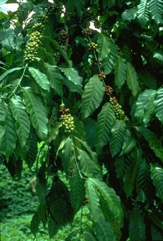
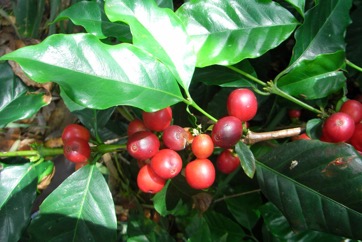
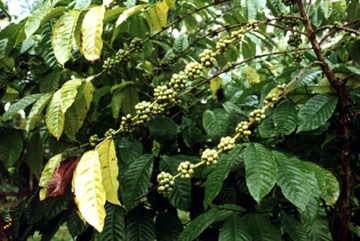
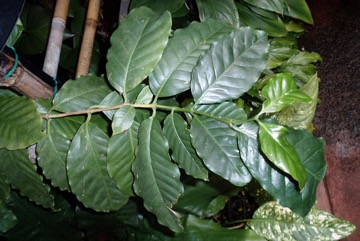
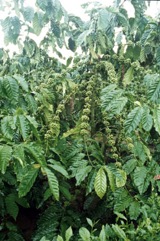
References
Ambasta, S.P. (Ed.), 2000, The Useful Plants of India. CSIR India. p 135
Anderson, E. F., 1993, Plants and people of the Golden Triangle. Dioscorides Press. p 207
Awas, T., 1997, A Study on the Ecology and Ethnobotany of Non-cultivated Food Plants and Wild Relatives of Cultivated crops in Gambella Region, Southwestern Ethiopia. Addis Ababa University. p 61
Barwick, M., 2004, Tropical and Subtropical Trees. A Worldwide Encyclopedic Guide. Thames and Hudson p 125
Bennett, B. C., 1990, Useful Plants of Amazonian Ecuador. US Agency for International Development. Fifth Progress Report. New York Botanical Gardens. p 39
Bianchini, F., Corbetta, F., and Pistoia, M., 1975, Fruits of the Earth. Cassell. p 216
Bodkin, F., 1991, Encyclopedia Botanica. Cornstalk publishing, p 270
Bodner, C. C. and Gereau, R. E., 1988, A Contribution to Bontoc Ethnobotany. Economic Botany, 43(2): 307-369
Bourke, R. M., Altitudinal limits of 230 economic crop species in Papua New Guinea. Terra australis 32.
Bourret, D., 1981, Bonnes-Plantes de Nouvelle-Caledonie et des Loyaute. ORSTOM. p 23
Bremness, L., 1994, Herbs. Collins Eyewitness Handbooks. Harper Collins. p 99
Brouk, B., 1975, Plants Consumed by Man. Academic Press, London. p 34
Brown, D., 2002, The Royal Horticultural Society encyclopedia of Herbs and their uses. DK Books. p 175
Burkill, H. M., 1985, The useful plants of west tropical Africa, Vol. 4. Kew.
Burkill, I.H., 1966, A Dictionary of the Economic Products of the Malay Peninsula. Ministry of Agriculture and Cooperatives, Kuala Lumpur, Malaysia. Vol 1 (A-H) p 635
Cobley, L.S. (rev. Steele, W.M.) 2nd Ed., 1976, An Introduction to the Botany of Tropical Crops. Longmans. p 203
Coe, F. G. and Anderson, G. J., 1999, Ethnobotany of the Sumu (Ulwa) of Southeastern Nicaragua and Comparisons with Miskitu Plant Lore. Economic Botany Vol. 53. No. 4. pp. 363-386
Cooper, W. and Cooper, W., 2004, Fruits of the Australian Tropical Rainforest. Nokomis Editions, Victoria, Australia. p 438
Cruz, I. M., et al, 2015, Edible fruits and seeds in the State of Mexico. Revista Mexicana de Ciencias Agricolas. Vol. 6. Num. 2 pp 331-346
Cundall, P., (ed.), 2004, Gardening Australia: flora: the gardener's bible. ABC Books. p 400
Dharani, N., 2002, Field Guide to common Trees & Shrubs of East Africa. Struik. p 214
Ekman Herbarium records Haiti
Etherington, K., & Imwold, D., (Eds), 2001, Botanica's Trees & Shrubs. The illustrated A-Z of over 8500 trees and shrubs. Random House, Australia. p 220
Facciola, S., 1998, Cornucopia 2: a Source Book of Edible Plants. Kampong Publications, p 212
Ferwerda, F.P., 1979, Coffees, in Simmonds, N.W., (ed), Crop Plant Evolution. Longmans. London. p 257
Flora of Australia Volume 49, Oceanic Islands 1, Australian Government Publishing Service, Canberra. (1994) p 357
Flowerdew, B., 2000, Complete Fruit Book. Kyle Cathie Ltd., London. p 209
Friday, J. B., 2005, Forestry and Agroforestry Trees of East Timor. http://www.ctahr.hawaii.edu/forestry/data/Timor/Timor trees.html
Hedrick, U.P., 1919, (Ed.), Sturtevant's edible plants of the world. p 209
Heywood, V.H., Brummitt, R.K., Culham, A., and Seberg, O. 2007, Flowering Plant Families of the World. Royal Botanical Gardens, Kew. p 285
Hu, Shiu-ying, 2005, Food Plants of China. The Chinese University Press. p 678
Jardin, C., 1970, List of Foods Used In Africa, FAO Nutrition Information Document Series No 2.p 68
Kiple, K.F. & Ornelas, K.C., (eds), 2000, The Cambridge World History of Food. CUP p 1760
Kybal, J., 1980, Herbs and Spices, A Hamlyn Colour Guide, Hamlyn Sydney p 78
Lazarides, M. & Hince, B., 1993, Handbook of Economic Plants of Australia, CSIRO. p 63
Lentz, D. L., 1986, Ethnobotany of the Jicaque of Honduras. Economic Botany 40(2):210-219
Llamas, K.A., 2003, Tropical Flowering Plants. Timber Press. p 325
Long, C., 2005, Swaziland's Flora - siSwati names and Uses http://www.sntc.org.sz/flora/
Lord, E.E., & Willis, J.H., 1999, Shrubs and Trees for Australian gardens. Lothian. p 217
Lyle, S., 2006, Discovering fruit and nuts. Land Links. p 149
Martin, F.W. & Ruberte, R.M., 1979, Edible Leaves of the Tropics. Antillian College Press, Mayaguez, Puerto Rico. p 60, 216
Maundu, P. et al, 1999, Traditional Food Plants of Kenya. National Museum of Kenya. 288p
Mengistu, F. & Hager, H., 2008, Wild Edible Fruit Species Cultural Domain, Informant Species Competence and Preference in Three Districts of Amhara Region, Ethiopia. Ethnobotany Research & Applications 6:487-502
Miguel, E., et al, 1989, A checklist of the cultivated plants of Cuba. Kulturpflanze 37. 1989, 211-357
Molla, A., Ethiopian Plant Names. http://www.ethiopic.com/aplants.htm
Morley, B. & Everard, B., 1970, Wild Flowers of the World. Ebury press. Plate 60
Norrington, L., & Campbell, C., 2001, Tropical Food Gardens. Bloomings Books. p 101
Peekel, P.G., 1984, (Translation E.E.Henty), Flora of the Bismarck Archipelago for Naturalists, Division of Botany, Lae, PNG. p 533, 532
Phon, P., 2000, Plants used in Cambodia. © Pauline Dy Phon, Phnom Penh, Cambodia. p 167
Plants of Haiti Smithsonian Institute http://botany.si.edu/antilles/West Indies
Purseglove, J.W., 1968, Tropical Crops Dicotyledons, Longmans. p 459
Recher, P, 2001, Fruit Spirit Botanical Gardens Plant Index. www.nrg.com.au/~recher/ seedlist.html p 1
Ruiters-Welcome, A. K., 2019, Food plants of southern Africa. Ph.D. thesis. Univ. of Johannesburg p 96
Schatz, G.E., 2001, Generic Tree Flora of Madagascar. Royal Botanical Gardens, Kew and Missouri Botanical Garden. p 327
Segura, S., et al, 2018, The edible fruit species in Mexico. Genet Resour Crop Evol (2018) 65:1767–1793
Shin, T., et al, 2018, Traditional knowledge of wild edible plants with special emphasis on medicinal uses in Southern Shan State, Myanmar. Journal of Ethnobiology and Ethnomedicine (2018) 14:48
Sillitoe, P. 1995, An Ethnobotanical Account of the Plant Resources of the Wola Region, Southern Highlands Province, Papua New Guinea. J. Ethnobiol. 15(2): 201-235
Small, E., 2009, Top 100 Food Plants. The world's most important culinary crops. NRC Research Press. p 207
Sp. pl. 1:172. 1753
Staples, G.W. and Herbst, D.R., 2005, A tropical Garden Flora. Bishop Museum Press, Honolulu, Hawaii. p 487
Sukarya, D. G., (Ed.) 2013, 3,500 Plant Species of the Botanic Gardens of Indonesia. LIPI p 615
Swaziland's Flora Database http://www.sntc.org.sz/flora
Tankard, G., 1990, Tropical fruit. An Australian Guide to Growing and using exotic fruit. Viking p 104
Thaman, R.R., 1976, The Tongan Agricultural System, University of the South Pacific, Suva, Fiji. p 391
van Wyk, B., 2005, Food Plants of the World. An illustrated guide. Timber press. p 147
Vasquez, R. and Gentry, A. H., 1989, Use and Misuse of Forest-harvested Fruits in the Iquitos Area. Conservation Biology 3(4): 350f
Vickery, M.L. and Vickery, B., 1979, Plant Products of Tropical Africa, Macmillan. p 61
Vivien, J., & Faure, J.J., 1996, Fruitiers Sauvages d'Afrique. Especes du Cameroun. CTA p 293
Walter, A. & Lebot, V., 2007, Gardens of Oceania. ACIAR Monograph No. 122. CD-ROM minor species p 10
Williams, C.N., Chew, W.Y., and Rajartnam, J.A., 1989, Tree and Field Crops of the Wetter Regions of the Tropics. Longman, p 61
Williamson, J., 2005, Useful Plants of Malawi. 3rd. Edition. Mdadzi Book Trust. p 72
World Checklist of Useful Plant Species 2020. Royal Botanic Gardens, Kew
www.worldagroforestrycentre.org/treedb/
Young, J., (Ed.), 2001, Botanica's Pocket Trees and Shrubs. Random House. p 260
Yuncker, T.G., 1959, Plants of Tonga, Bernice P. Bishop Museum, Hawaii, Bulletin 220. p 152
Zaldivar, M. E., et al, 2002, Species Diversity of Edible Plants Grown in Homegardens of Chibehan Amerindians from Costa Rica. Human Ecology, Vol. 30, No. 3, pp. 301-316
Zizka, G., 1991, Flowering Plants of Easter Island. Palmarum Hortus Francofurtensis
Zuchowski W., 2007, Tropical Plants of Costa Rica. A Zona Tropical Publication, Comstock Publishing. p 194